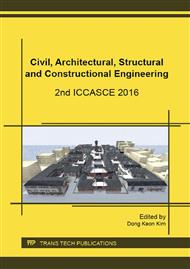[1]
ATC, Seismic vulnerability and impact of disruption of lifelines in the Coterminous United States, Redwood City, CA: Applied Technology Council, (1991).
Google Scholar
[2]
H. Hwang, J. B. Jernigan, Y. W. Lin, Evaluation of seismic damage to Memphis bridges and highway systems, ASCE J. Bridge Eng. 5(4) (2000) 322-330.
DOI: 10.1061/(asce)1084-0702(2000)5:4(322)
Google Scholar
[3]
M. Shinozuka, M. Q. Feng, H. Kim, S. Kim, Nonlinear static procedure for fragility curve development, J. Eng. Mech. 126(12) (2000) 1287-1295.
DOI: 10.1061/(asce)0733-9399(2000)126:12(1287)
Google Scholar
[4]
B. G. Nielson, R. DesRoches, Seismic fragility curves for typical highway bridge classes in the Central and Southeastern United States, Earthq. Spectra, 23 (2007) 615-633.
DOI: 10.1193/1.2756815
Google Scholar
[5]
B. G. Nielson, R. DesRoches, Seismic fragility methodology for highway bridges using a component level approach, Earthq. Eng. Struct. Dynam. 36(6) (2007) 823-839.
DOI: 10.1002/eqe.655
Google Scholar
[6]
J. E. Padgett, R. DesRoches, Methodology for the development of analytical fragility curves for retrofitted bridges, Earthq. Eng. Struct. Dynam. 37(8) (2008) 157-174.
DOI: 10.1002/eqe.801
Google Scholar
[7]
Y. Pan, A. K. Agrawal, M. Ghosn, S. Alampalli, Seismic fragility of multi-span simply supported steel highway bridges in New York State. I: Bridge modeling, parametric analysis, and retrofit design, ASCE J. Bridge Eng. 15(5) (2010) 448-461.
DOI: 10.1061/(asce)be.1943-5592.0000085
Google Scholar
[8]
Y. Pan, A. K. Agrawal, M. Ghosn, S. Alampalli, Seismic fragility of multi-span simply supported steel highway bridges in New York State. II: Fragility analysis, fragility curves, and fragility surfaces, ASCE J. Bridge Eng. 15(5) (2010) 462-472.
DOI: 10.1061/(asce)be.1943-5592.0000055
Google Scholar
[9]
HAZUS-MH 2. 1, Multi-Hazard Loss Estimation Methodology: Earthquake Model HAZUS-MH 2. 1 Technical Manual, Washington, DC: Federal Emergency Management Agency, (2012).
DOI: 10.17077/etd.18d7eydp
Google Scholar
[10]
National Bureau of Statistics of China, China statistical yearbook 2015, Beijing, China Statistics Press Inc., (2016).
Google Scholar
[11]
E. Chio, Seismic analysis and retrofit of mid-America bridges. Georgia Institute of Technology, Atlanta, GA, (2002).
Google Scholar
[12]
CALTRANS, Seismic design criteria, CA: California Department of Transportation, (2013).
Google Scholar
[13]
N. Shome, C. A. Cornell, P. Bazzurro, J. E. Caraballo, Earthquakes, records, and nonlinear responses, EERI Earthq. Spectra, 14(3) (1998) 467-500.
DOI: 10.1193/1.1586011
Google Scholar
[14]
B. G. Nielson, R. DesRoches, Effect of using PGA versus Sa on the uncertainty in probabilistic seismic demand models of highway bridges, 8th National Conference on Earthquake Engineering, Earthquake Engineering Research Institute, San Francisco, (2006).
Google Scholar
[15]
C. A. Cornell, Bounds on the reliability of structural system, J. Struct. Div., 93(1) (1996) 171-200.
Google Scholar


